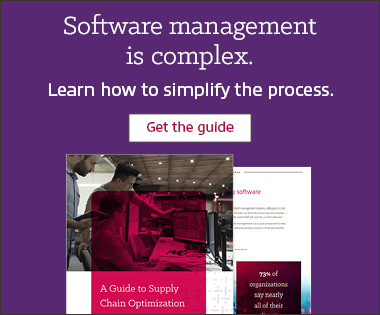Article Software as a Service (SaaS) Overview: Subscription Software Is Here to Stay
The SaaS framework is here to stay. Why? Properly managed, it helps organizations reduce procurement costs and improve scalability.
By Krista Leland / 9 Jul 2019 / Topics: As a service Software Procurement

When it comes to organizational efficiency, there can be a tendency to focus on business outputs: how much is being produced, how quickly projects are completed and how many sales are made.
It’s easy to overlook internal processes, such as procurement, that typically take place behind the scenes. But providing your workforce with the right tools at the right time — for the right price — plays a significant role in the overall productivity and profitability of your business.
According to the 2019 Insight Intelligent Technology Index, 63% of IT professionals who feel their IT supply chain is not optimized say an improvement in this area would make their workforce more efficient as a whole.
This should come as no surprise. As technology becomes more integrated into organizations across every industry, more of the tools workers rely on the most fall into the IT category, and software is no exception. As a result, procurement specialists face increasing challenges related to software asset management — from budgeting and deployment to security and compliance.
Market shifts toward subscription licensing and Software as a Service (SaaS) promise to simplify software management and reduce costs. But a wide range of pricing structures and deployment options can make it difficult to determine how these models will affect your business.
The rise of subscription-based services
From shaving kits and readymade meals to dog toys, clothing and even golf clubs, the subscription-based business model seems to have taken off as a market trend. However, the strategy itself dates back much further.
Shortly after the dawn of the printing press, newspaper publishers became the first businesses to adopt a recurring revenue model. Over time, subscription offerings evolved in sync with readily available technologies, expanding from newspapers and magazines to broadcast television, telephone and internet services.
That paved the way for the development of subscription-based digital media, first popularized by companies such as Netflix, as it made the transition from a mail-in model to web streaming. The convenience and cost savings over traditional procurement methods soon opened doors for other digital subscription offerings as well — from music to software.
Software procurement, once restricted to the upfront purchase of a physical asset, progressed to direct downloads before evolving to subscription-based software licensing. Users gained the ability to choose between annual or monthly licensing fees, as well as simplified procurement with a lower cost of entry.
The evolution of the SaaS licensing
While subscription software offers significant benefits in terms of pricing structure and e-procurement options, there remains room for improvement.
Traditional subscription licensing involves installing and managing applications on premises. That means manual updates and hands-on deployments are often required in order to take advantage of new features or security patches.
But in an age of rapid change and emerging cyberthreats, managing subscription licenses at high volume can quickly become a burden for IT teams. Recognizing the need for further optimization, software providers have built upon the convenience and cost savings, taking subscription licensing to the next level.
The SaaS framework allows software publishers or third parties to host applications in the cloud. This provides user access via internet connection and eliminates the need for organizations to store applications locally. It also minimizes the cost of acquisition and the burden of software management.
Reducing software expenses
Unlike perpetual licenses, which typically require a large upfront investment, most SaaS procurement models provide a lower cost of entry for small businesses and individual contractors looking to access the same powerful tools used by leading corporations.
Users benefit from increased budget predictability and a faster return by categorizing software investments as Operating Expenses (OpEx) rather than Capital Expenditures (CapEx).
In addition, subscription-based SaaS reduces investment risk, allowing users to cancel licenses as soon as they’re no longer needed or desired. This flexibility not only makes it easier to evaluate new business tools without fear of wasting funds, but it also helps incentivize software providers to continue improving their products.
Time-saving convenience
Beyond cost savings, SaaS offers significant management benefits for IT teams, procurement specialists and users alike. Since SaaS applications are hosted by the provider, updates and security patches can be rolled out automatically, eliminating the need for manual intervention while ensuring users always have access to the latest features.
The cloud-based nature of SaaS also improves workforce productivity and mobility, allowing users to access programs and files from any internet-connected device. And, SaaS translates to greater vertical scalability, as licenses can be easily expanded or reduced based on changing business requirements.
Blazing the SaaS trail
Although not every software provider has embraced SaaS, it certainly represents the future of licensing. Let’s take a look at how one company has implemented subscription-based SaaS.
Creative application provider Adobe has pioneered the SaaS model with its Value Incentive Plan (VIP). Adobe VIP gives its customers flexible, on-demand access to Creative Cloud and Acrobat DC. While perpetual licenses are still available, VIP provides a unique example of the cost- and time-saving advantages of SaaS.
The VIP procurement approach allows businesses to purchase and assign licenses as needed, rather than strictly on an annual basis. Volume discounts are available for one-, two- or three-year subscriptions, making it easy for users to maximize their savings. Flexible terms even allow administrators to sync renewal dates for greater efficiency and budget predictability.
Like many SaaS solutions, the Adobe VIP platform includes a unified management dashboard for a simplified view of activated software — with the added benefit of 24/7 advanced technical support.
From the dashboard, IT teams and procurement specialists can easily customize software packages, assign and unassign licenses, and track automatic updates. This reduces complexity, ensures ongoing security and compliance, and eliminates downtime due to gaps in licensing.
Maximizing the value of SaaS
The combination of cost savings, manageability and scalability has led to the rapid adoption of SaaS. But, just as there are benefits to subscription-based software, there are several points to consider before fully embracing it.
As software providers move further into the SaaS model, license compliance audits are becoming more common — and costly — in cases of misuse. Although many SaaS solutions come with centralized dashboards, not all are as straightforward or as easy to use as the Adobe VIP platform.
Even when individual dashboards do offer complete transparency into a single vendor’s software, enterprises may find it challenging to manage a wide range of vendor platforms simultaneously. A systems integrator such as Insight can help take the remaining guesswork out of managing SaaS.
When selecting an IT partner for your organization, look for one with comprehensive software asset management tools that provide true visibility across licenses and vendors. Audit prevention and defense capabilities are also crucial to ensure you always have access to the licenses you’re entitled to — without putting your business at risk of financial penalty.




